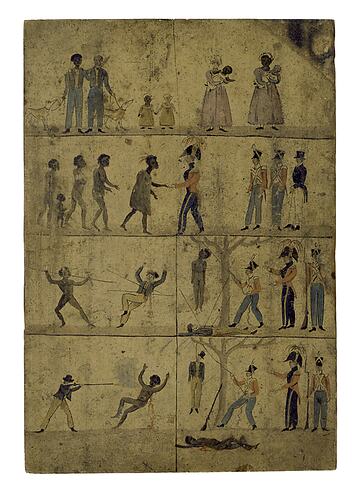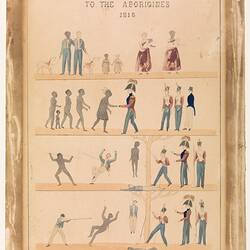Summary
Proclamation boards were ordered by George Franklin, the Surveyor General of 'Van Diemen's Land' (now Tasmania), to be 'fastened to trees' in remote locations in Tasmania where Aboriginal people had withdrawn and 'are most likely to see them'. Lieutenant Governor George Arthur had declared martial law against 'several Black or Aboriginal natives within the several Districts of the Island' in November 1828. The Surveyor General, George Frankland, who was also a linguist and artist, suggested to Arthur that 'in the absence of successful communication with these unfortunate people with whose language we are totally unacquainted... it might be possible... to impart to them . . . the real wishes of the government towards them'. Frankland had seen drawings by Aboriginal people on the bark of trees, and intrigued by this 'newly discovered faculty' he sketched a series of Aboriginal and European figures, showing friendship and equality before the British law. It was, however, to the white man's ways Aboriginal people would adapt. In 1830 when the government's intention to produce such pictographs was announced, the Colonial Times noted sardonically that the cause of Aboriginal hostility must be 'more deeply probed, or their taste as connoisseurs of paintings be more clearly established'. Soon after, Arthur instigated the operation known as the 'Black Line': an attempt to capture or force Aboriginal people into the Forestier Peninsula. Frankland was at Arthur's side throughout this violent exercise.
Physical Description
Proclamation Board made from a rectangular panel of solid, sawn Kauri Pine. There are six panels of acrylic colours on sized ground: (a) First line: Full width panel depicting an Indigenous male and a European male standing together, dressed in European clothing, each holding a hound dog on a lead. Beside them are two children, one Indigenous and one European, each in European dress. To their left are two adults, one European woman holding an Indigenous baby, and one Indigenous woman holding a European baby. Each in European dress. (b) Second line: Full width panel depicting five Indigenous figures, dressed (and partially dressed) in traditional clothing, including a small child. The lead male is being greeted by a uniformed military officer who is wearing a plumed head dress. Standing aside are two uniformed soldiers and a European gentleman dressed in a blue short coat and a top hat. (c) Third line: Half width panel depicting a naked Indigenous male spearing a fully clad European male. (d) Third line: Half width panel depicting the hanging of the Indigenous male, the body of the speared European on the ground beside a tree, and three uniformed soldiers perform the hanging. (e) Fourth line: Half width panel depicting a fully clad European male shooting an Indigenous male. (f) Fourth line: Half width panel depicting a European male being hung on a similar tree, with the body of the slain Indigenous male on the ground. The hanging is being performed by similar uniformed soldiers to (e). Reverse: Signature of G. A. Robinson, Esq. Also charcoal coloured figures in the form of calculations (scattered).
Significance
This is one of only a handful of examples of Proclamation Boards that have survived from the 1830s. It comes from the collection of George Augustus Robinson, who Lieutenant Governor George Arthur of 'Van Diemen's Land' (Tasmania) selected to conciliate Aboriginal Tasmanians, and it is believed he carried the boards for that specific purpose.
More Information
-
Object/Medium
Painting
-
Locality
-
Date Produced
-
Collector
-
Fully Extended
233 (Length), 330 (Height)
-
Previous Owner
-
Keywords
-
References
[Book] Museum Victoria. 2004. Treasures of the Museum. Victoria, Australia. 206.
-
Collection Names
-
Type of item
-
Discipline
-
Category
-
Collecting Areas

